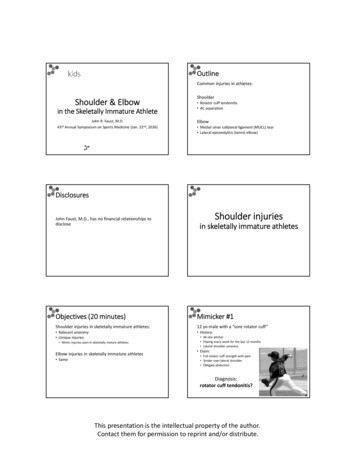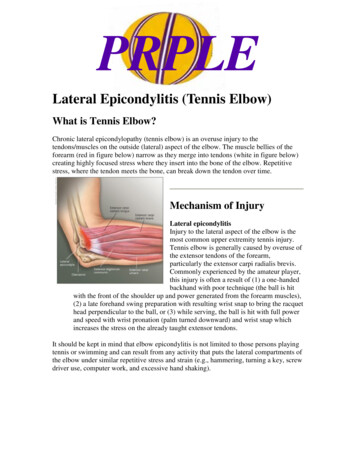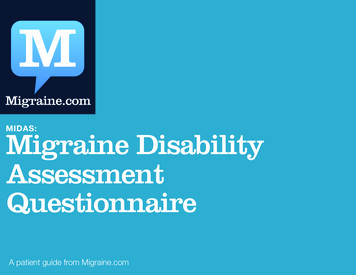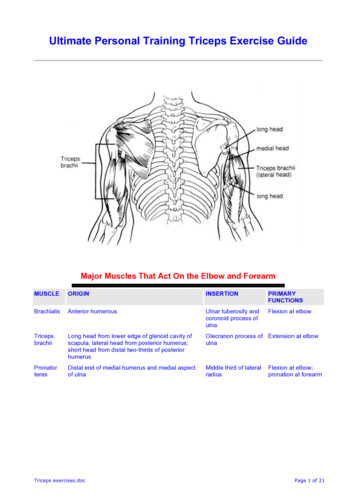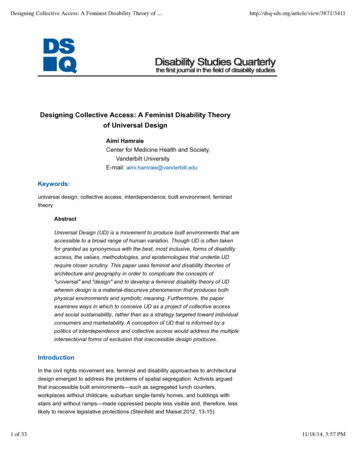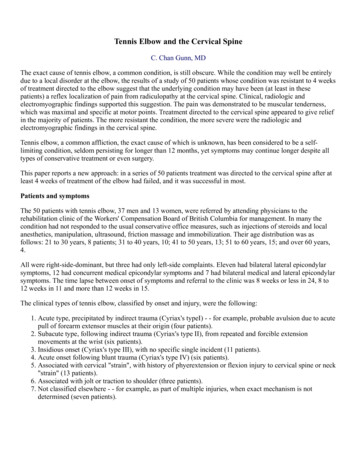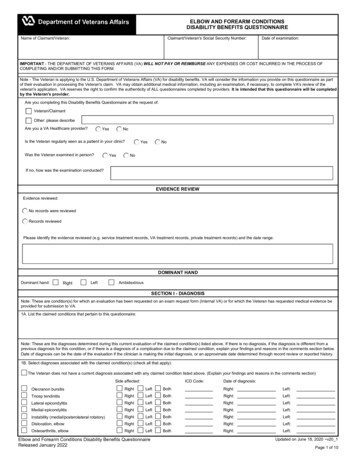
Transcription
ELBOW AND FOREARM CONDITIONSDISABILITY BENEFITS QUESTIONNAIREName of Claimant/Veteran:Claimant/Veteran's Social Security Number:Date of examination:IMPORTANT - THE DEPARTMENT OF VETERANS AFFAIRS (VA) WILL NOT PAY OR REIMBURSE ANY EXPENSES OR COST INCURRED IN THE PROCESS OFCOMPLETING AND/OR SUBMITTING THIS FORM.Note - The Veteran is applying to the U.S. Department of Veterans Affairs (VA) for disability benefits. VA will consider the information you provide on this questionnaire as partof their evaluation in processing the Veteran's claim. VA may obtain additional medical information, including an examination, if necessary, to complete VA's review of theveteran's application. VA reserves the right to confirm the authenticity of ALL questionnaires completed by providers. It is intended that this questionnaire will be completedby the Veteran's provider.Are you completing this Disability Benefits Questionnaire at the request of:Veteran/ClaimantOther: please describeAre you a VA Healthcare provider?YesNoIs the Veteran regularly seen as a patient in your clinic?Was the Veteran examined in person?YesYesNoNoIf no, how was the examination conducted?EVIDENCE REVIEWEvidence reviewed:No records were reviewedRecords reviewedPlease identify the evidence reviewed (e.g. service treatment records, VA treatment records, private treatment records) and the date range.DOMINANT HANDDominant hand:RightLeftAmbidextrousSECTION I - DIAGNOSISNote: These are condition(s) for which an evaluation has been requested on an exam request form (Internal VA) or for which the Veteran has requested medical evidence beprovided for submission to VA.1A. List the claimed conditions that pertain to this questionnaire:Note: These are the diagnoses determined during this current evaluation of the claimed condition(s) listed above. If there is no diagnosis, if the diagnosis is different from aprevious diagnosis for this condition, or if there is a diagnosis of a complication due to the claimed condition, explain your findings and reasons in the comments section below.Date of diagnosis can be the date of the evaluation if the clinician is making the initial diagnosis, or an approximate date determined through record review or reported history.1B. Select diagnoses associated with the claimed condition(s) (check all that apply):The Veteran does not have a current diagnosis associated with any claimed condition listed above. (Explain your findings and reasons in the comments section)Side affected:ICD Code:Date of diagnosis:Olecranon bursitisRightLeftBothRight:Left:Tricep tendinitisRightLeftBothRight:Left:Lateral epicondylitisRightLeftBothRight:Left:Medial epicondylitisRightLeftBothRight:Left:Instability (medial/posterolateral rotatory)RightLeftBothRight:Left:Dislocation, elbowRightLeftBothRight:Left:Osteoarthritis, elbowRightLeftBothRight:Left:Elbow and Forearm Conditions Disability Benefits QuestionnaireReleased January 2022Updated on June 18, 2020 v20 1Page 1 of 10
SECTION I - DIAGNOSIS (continued)Side affected:ICD Code:Date of diagnosis:Total elbow arthroplastyRightLeftBothRight:Ankylosis of elbow jointDegenerative arthritis, other tBothRight:Left:Arthritis, gonorrhealRightLeftBothRight:Left:Arthritis, pneumococcicRightLeftBothRight:Left:Arthritis, streptococcicRightLeftBothRight:Left:Arthritis, syphiliticRightLeftBothRight:Left:Arthritis, rheumatoid (multi-joint)RightLeftBothRight:Left:Arthritis, post-traumaticRightLeftBothRight:Left:Arthritis, typhoidRightLeftBothRight:Left:Other specified forms of arthropthy(excluding gout) (specify)RightLeftBothRight:Left:Osteoporosis, residuals ofRightLeftBothRight:Left:Osteomalacia, residuals ofRightLeftBothRight:Left:Bones, neoplasm, benignRightLeftBothRight:Left:Osteitis sRightLeftBothRight:Left:Heterotopic ossificationRightLeftBothRight:Left:Tendinopathy (select one if ght:Left:RightLeftBothRight:Left:Left:Other (specify)Other diagnosis #1:Other diagnosis #2:If there are additional diagnoses that pertain to an elbow or forearm condition, please list using above format:1C. Comments, if any:Note: In all forearm injuries, if there are impaired finger movements due to tendon, muscle, or nerve injuries, also complete the appropriate additional questionnaire(s).SECTION II - MEDICAL HISTORY2A. Describe the history (including onset and course) of the Veteran's elbow and/or forearm condition (brief summary).2B. Does the Veteran report flare-ups of the elbow or forearm?YesNoIf yes, document the Veteran's description of flare-ups he or she experiences, including the frequency, duration, characteristics, precipitating and alleviating factors,severity and/or extent of the functional impairment he or she experiences during a flare-up of symptoms:2C. Does the Veteran report having any functional loss or functional impairment of the joint or extremity being evaluated on this questionnaire, including but not limited toafter repeated use over time?YesNoIf yes, document the Veteran's description of functional loss or functional impairment in his or her own words:Elbow and Forearm Conditions Disability Benefits QuestionnaireReleased January 2022Updated on June 18, 2020 v20 1Page 2 of 10
SECTION II - MEDICAL HISTORY (continued)2D. Are there complaints of painful motion on flexion and/or extension?YesNoIf yes, check all that apply:FlexionExtensionIf yes, is the complaint of painful motion related to the claimed condition(s) identified in the diagnosis section?YesNoIf yes, please specify the condition(s)If no, describe what it is attributed to:2E. Are there complaints of painful motion on forearm supination and/or pronation?YesNoIf yes, check all that apply:Forearm supinationForearm pronationIf yes, is the complaint of painful motion related to the claimed condition(s) identified in the diagnosis section?YesNoIf yes, please specify the condition(s)If no, describe what it is attributed to:SECTION III - RANGE OF MOTION (ROM) AND FUNCTIONAL LIMITATIONThere are several separate parameters requested for describing function of a joint. The question "Does this ROM contribute to a functional loss?" asks if there is a functionalloss that can be ascribed to any documented loss of range of motion; and, unlike later questions, does not take into account the numerous other factors to be considered.Subsequent questions take into account additional factors such as pain, fatigue, weakness, lack of endurance, or incoordination. If there is pain noted on examination, it isimportant to understand whether or not that pain itself contributes to functional loss. Ideally, a claimant would be seen immediately after repetitive use over time or during aflare-up; however, this is not always feasible.Information regarding joint function on repetitive use is broken up into two subsets. The first subset is based on observed repetitive use, and the second is based onfunctional loss associated with repeated use over time. The observed repetitive use section initially asks for objective findings after three or more repetitions of range ofmotion testing. The second subset provides a more global picture of functional loss associated with repetitive use over time. The latter takes into account medical probabilityof additional functional loss as a global view. This takes into account not only the objective findings noted on the examination, but also the subjective history provided by theclaimant, as well as review of the available medical evidence.Optimally, a description of any additional loss of function should be provided - such as what the degrees of range of motion would be opined to look like after repetitive useover time. However, when this is not feasible, an "as clear as possible" description of that loss should be provided. This same information (minus the three repetitions) isasked to be provided with regards to flare-ups.3A. Initial ROM measurements:RightelbowAll NormalAbnormal or outside of normal rangeUnable to testNot indicatedLeftelbowIf unable to test or not indicated, please explain:All NormalAbnormal or outside of normal rangeUnable to testNot indicatedIf unable to test or not indicated, please explain:If ROM is outside of "normal" range, but is normal for the Veteran (for reasons otherthan an elbow condition, such as age, body habitus, neurologic disease), pleasedescribe:If ROM is outside of "normal" range, but is normal for the Veteran (for reasons otherthan an elbow condition, such as age, body habitus, neurologic disease), pleasedescribe:If abnormal, does the range of motion itself contribute to a functional loss?If abnormal, does the range of motion itself contribute to a functional loss?YesNoIf yes, please explain:YesNoIf yes, please explain:Note: For any joint condition, examiners should address pain on both passive and active motion, and on both weight-bearing and nonweight-bearing. Examiners should alsotest the contralateral joint (unless medically contraindicated). If testing cannot be performed, or is medically contraindicated (such as it may cause the Veteran severe pain orthe risk of further injury), an explanation must be given. Please note any characteristics of pain observed on examination (such as facial expression or wincing onpressure or manipulation).Can testing be performed?YesNoCan testing be performed?YesIf no, provide an explanation:If no, provide an explanation:If this is the unclaimed joint, is it:If this is the unclaimed joint, is it:DamagedUndamagedIf undamaged, range of motion testing must be conducted.Elbow and Forearm Conditions Disability Benefits QuestionnaireReleased January 2022DamagedNoUndamagedIf undamaged, range of motion testing must be conducted.Updated on June 18, 2020 v20 1Page 3 of 10
SECTION III - RANGE OF MOTION (ROM) AND FUNCTIONAL LIMITATION (continued)Active Range of Motion (ROM) Perform active range of motion and provide the ROM values:RightelbowActive Range of Motion (ROM) Perform active range of motion and provide the ROM values:LeftelbowFlexion endpoint (145 degrees)degreesExtension endpoint (0 degrees)degreesExtension endpoint (0 degrees)Forearm supination endpoint (85 degrees)degreesForearm supination endpoint (85 degrees)Forearm pronation endpoint (80 degrees)degreesForearm pronation endpoint (80 degrees)If noted on examination, which ROM exhibited pain? (select all that apply):Flexion endpoint (145 degrees)If noted on examination, which ROM exhibited pain? (select all that apply):FlexionForearm supinationFlexionForearm supinationExtensionForearm pronationExtensionForearm pronationIf any limitation of motion is specifically attributable to pain, weakness, fatigability,incoordination, or other, please note the degree(s) in which limitation of motion isspecifically attributable to the factors identified and describe.If any limitation of motion is specifically attributable to pain, weakness, fatigability,incoordination, or other, please note the degree(s) in which limitation of motion isspecifically attributable to the factors identified and describe.Flexion degree endpoint (if different than above)Flexion degree endpoint (if different than above)Extension degree endpoint (if different than above)Extension degree endpoint (if different than above)Forearm supination degree endpoint (if different than above)Forearm supination degree endpoint (if different than above)Forearm pronation degree endpoint (if different than above)Forearm pronation degree endpoint (if different than above)Passive range of motion Perform passive range of motion and provide ROM values:Passive range of motion Perform passive range of motion and provide ROM values:Flexion endpoint (145 degrees):degreesSame as active ROMFlexion endpoint (145 degrees):degreesSame as active ROMExtension endpoint (0 degrees):degreesSame as active ROMExtension endpoint (0 degrees):degreesSame as active ROMForearm supination endpoint (85 degrees):degreesSame as active ROMForearm supination endpoint (85 degrees):degreesSame as active ROMForearm pronation endpoint (80 degrees):degreesSame as active ROMForearm pronation endpoint (80 degrees):degreesSame as active ROMIf noted on examination, which passive ROM exhibited pain? (select all that apply):If noted on examination, which passive ROM exhibited pain? (select all that apply):FlexionForearm supinationFlexionForearm supinationExtensionForearm pronationExtensionForearm pronationIf any limitation of motion is specifically attributable to pain, weakness, fatigability,incoordination, or other, please note the degree(s) in which limitation of motion isspecifically attributable to the factors identified and describe.If any limitation of motion is specifically attributable to pain, weakness, fatigability,incoordination, or other, please note the degree(s) in which limitation of motion isspecifically attributable to the factors identified and describe.Flexion degree endpoint (if different than above)Flexion degree endpoint (if different than above)Extension degree endpoint (if different than above)Extension degree endpoint (if different than above)Forearm supination degree endpoint (if different than above)Forearm supination degree endpoint (if different than above)Forearm pronation degree endpoint (if different than above)Forearm pronation degree endpoint (if different than above)Is there evidence of pain?YesNoIf yes, check all that apply:Is there evidence of pain?YesNoIf yes, check all that gActive motionPassive motionActive motionPassive motionOn rest/non-movementDoes not result in/cause functional lossOn rest/non-movementDoes not result in/cause functional lossCauses functional loss (if checked, describe below):Is there objective evidence of crepitus?YesNoIs there objective evidence of localized tenderness or pain on palpation of the joint orassociated soft tissue?YesNoIf yes, please explain. Include location, severity, and relationship to condition(s):Elbow and Forearm Conditions Disability Benefits QuestionnaireReleased January 2022Non-weightbearingCauses functional loss (if checked, describe below):Is there objective evidence of crepitus?YesNoIs there objective evidence of localized tenderness or pain on palpation of the joint orassociated soft tissue?YesNoIf yes, please explain. Include location, severity, and relationship to condition(s):Updated on June 18, 2020 v20 1Page 4 of 10
SECTION III - RANGE OF MOTION (ROM) AND FUNCTIONAL LIMITATION (continued)3B. Observed repetitive use ROM:RightelbowIs the Veteran able to perform repetitive-use testing with at least threerepetitions?YesNoIf no, please explain:Is there additional loss of function, or range of motion, after three repetitions?YesNoIf yes, please respond to the following after the completion of the three repetitions:LeftelbowIs the Veteran able to perform repetitive-use testing with at least threerepetitions?YesNoIf no, please explain:Is there additional loss of function, or range of motion, after three repetitions?YesNoIf yes, please respond to the following after the completion of the three repetitions:Flexion endpoint (145 degrees)degreesFlexion endpoint (145 degrees)degreesExtension endpoint (0 degrees)degreesExtension endpoint (0 degrees)degreesSupination endpoint (85 degrees)degreesSupination endpoint (85 degrees)degreesPronation endpoint (80 degrees)degreesPronation endpoint (80 degrees)degreesSelect factors that cause this functional loss. (check all that apply)Select factors that cause this functional loss. (check all that nessLack of enduranceIncoordinationN/ALack of enduranceIncoordinationN/AOther (specify):Other (specify):Note: When pain is associated with movement, the examiner must give a statement on whether pain could significantly limit functional ability during flare-ups and/or afterrepeated use over time in terms of additional loss of range of motion. In the exam report, the examiner is requested to provide an estimate of decreased range of motion (indegrees) that reflect frequency, duration, and during flare-ups - even if not directly observed during a flare-up and/or after repeated use over time.3C. Repeated use over time:RightelbowIs the Veteran being examined immediately after repeated useover time?YesNoLeftelbowIs the Veteran being examined immediately after repeated useover time?YesNoDoes procured evidence (statements from the Veteran) suggest pain, fatigability,weakness, lack of endurance, or incoordination which significantly limits functionalability with repeated use over time?NoYesDoes procured evidence (statements from the Veteran) suggest pain, fatigability,weakness, lack of endurance, or incoordination which significantly limits functionalability with repeated use over time?NoYesSelect factors that cause this functional loss. (check all that apply)Select factors that cause this functional loss. (check all that nessLack of enduranceIncoordinationN/ALack of enduranceIncoordinationN/AOther (specify):Other (specify):Estimate range of motion in degrees for this joint immediately after repeated use overtime based on information procured from relevant sources, including the laystatements of the Veteran:Estimate range of motion in degrees for this joint immediately after repeated use overtime based on information procured from relevant sources, including the laystatements of the Veteran:Flexion endpoint (145 degrees):degreesFlexion endpoint (145 degrees):Extension endpoint (0 degrees):degreesExtension endpoint (0 degrees):degreesForearm supination endpoint (85 degrees):degreesForearm supination endpoint (85 degrees):degreesForearm pronation endpoint (80 degrees):degreesForearm pronation endpoint (80 degrees):degreesdegreesThe examiner should provide the estimated range of motion based on a review of allprocurable information - to include the Veteran's statement on examination, casespecific evidence (to include medical treatment records when applicable and layevidence), and the examiner's medical expertise. If, after evaluation of the procurableand assembled data, the examiner determines that it is not feasible to provide thisestimate, the examiner should explain why an estimate cannot be provided. Theexplanation should not be based on an examiner's shortcomings, or a generalaversion to offering an estimate on issues not directly observed.The examiner should provide the estimated range of motion based on a review of allprocurable information - to include the Veteran's statement on examination, casespecific evidence (to include medical treatment records when applicable and layevidence), and the examiner's medical expertise. If, after evaluation of the procurableand assembled data, the examiner determines that it is not feasible to provide thisestimate, the examiner should explain why an estimate cannot be provided. Theexplanation should not be based on an examiner's shortcomings, or a generalaversion to offering an estimate on issues not directly observed.Please cite and discuss evidence here. (Must be specific to the case, and based onall procurable evidence.)Please cite and discuss evidence here. (Must be specific to the case, and based onall procurable evidence.)3D. Flare-ups:RightelbowIs the examination being conducted during a flare-up?YesNoLeftelbowIs the examination being conducted during a flare-up?YesNoDoes procured evidence (statements from the Veteran) suggest pain, fatigability,weakness, lack of endurance, or incoordination which significantly limits functionalability with flare-ups?NoYesDoes procured evidence (including lay testimony) suggest pain, fatigability,weakness, lack of endurance, or incoordination which significantly limits functionalability with flare-ups?YesNoSelect factors that cause this functional loss. (check all that apply)Select factors that cause this functional loss. (check all that nessLack of enduranceIncoordinationN/ALack of enduranceIncoordinationN/AOther (specify):Elbow and Forearm Conditions Disability Benefits QuestionnaireReleased January 2022Other (specify):Updated on June 18, 2020 v20 1Page 5 of 10
SECTION III - RANGE OF MOTION (ROM) AND FUNCTIONAL LIMITATION (continued)Estimate range of motion in degrees for this joint during flare-upsbased on information procured from relevant sources including thelay statements of the Veteran:RightelbowEstimate range of motion in degrees for this joint during flare-upsbased on information procured from relevant sources including thelay statements of the Veteran:LeftelbowFlexion endpoint (145 degrees):degreesFlexion endpoint (145 degrees):degreesExtension endpoint (0 degrees):degreesExtension endpoint (0 degrees):degreesForearm supination endpoint (85 degrees):degreesForearm supination endpoint (85 degrees):degreesForearm pronation endpoint (80 degrees):degreesForearm pronation endpoint (80 degrees):degreesThe examiner should provide the estimated range of motion based on a review ofall procurable information - to include the Veteran's statement on examination,case-specific evidence (to include medical treatment records when applicableand lay evidence), and the examiner's medical expertise. If, after evaluation of theprocurable and assembled data, the examiner determines that it is not feasible toprovide this estimate, the examiner should explain why an estimate cannot beprovided. The explanation should not be based on an examiner's shortcomings,or a general aversion to offering an estimate on issues not directly observed.The examiner should provide the estimated range of motion based on a review ofall procurable information - to include the Veteran's statement on examination,case-specific evidence (to include medical treatment records when applicableand lay evidence), and the examiner's medical expertise. If, after evaluation of theprocurable and assembled data, the examiner determines that it is not feasible toprovide this estimate, the examiner should explain why an estimate cannot beprovided. The explanation should not be based on an examiner's shortcomings,or a general aversion to offering an estimate on issues not directly observed.Please cite and discuss evidence here. (Must be specific to the case, and based onall procurable evidence.)Please cite and discuss evidence here. (Must be specific to the case, and based onall procurable evidence.)3E. Additional factors contributing to disability:RightelbowIn addition to those addressed above, are there additional contributingfactors of disability? Please select all that apply and describe:LeftelbowIn addition to those addressed above, are there additional contributingfactors of disability? Please select all that apply and describe:NoneInterference with sittingNoneInterference with sittingInterference with standingSwellingInterference with standingSwellingDisturbance of locomotionDeformityDisturbance of locomotionDeformityLess movement than normalMore movement than normalLess movement than normalMore movement than normalWeakened movementAtrophy of disuseWeakened movementAtrophy of disuseInstability of stationOther, describe:Instability of stationOther, describe:Please describe additional contributing factors of disability:Please describe additional contributing factors of disability:SECTION IV - MUSCLE ATROPHYRightelbow4A. Does the Veteran have muscle atrophy?YesNo4B. If yes, is the muscle atrophy due to the claimed condition in the diagnosissection?YesNoLeftelbow4A. Does the Veteran have muscle atrophy?YesNo4B. If yes, is the muscle atrophy due to the claimed condition in the diagnosissection?YesNoIf no, provide rationale here:If no, provide rationale here:4C. For any muscle atrophy due to a diagnosis listed in Section I, indicate specificlocation of atrophy, providing measurements in centimeters of normal side andcorresponding atrophied side, measured at maximum muscle bulk:Right upper extremity: specify location of measurementsuch as "10cm above or below elbow":4C. For any muscle atrophy due to a diagnosis listed in Section I, indicate specificlocation of atrophy, providing measurements in centimeters of normal side andcorresponding atrophied side, measured at maximum muscle bulk:Left upper extremity: specify location of measurementsuch as "10cm above or below elbow":Circumference of normal side:cmCircumference of normal side:cmCircumference of atrophied side:cmCircumference of atrophied side:cm4D. Comments, if any:Elbow and Forearm Conditions Disability Benefits QuestionnaireReleased January 20224D. Comments, if any:Updated on June 18, 2020 v20 1Page 6 of 10
SECTION V- ANKYLOSISNote: Ankylosis is the immobilization of a joint due to disease, injury, or surgical procedure.RightelbowLeftelbow5A. Is there ankylosis of the elbow and/or forearm?YesNoIf yes, indicate the severity of ankylosis:5A. Is there ankylosis of the elbow and/or forearm?YesNoIf yes, indicate the severity of ankylosis:Favorable ankylosis, at an angle between 90 degrees and 70 degreesFavorable ankylosis, at an angle between 90 degrees and 70 degreesIntermediate ankylosis, at an angle of more than 90 degrees, orbetween 70 and 50 degreesIntermediate ankylosis, at an angle of more than 90 degrees, orbetween 70 and 50 degreesUnfavorable ankylosisUnfavorable ankylosisAt an angle of less than 50 degreesAt an angle of less than 50 degreesWith complete loss of supinationWith complete loss of supinationWith complete loss of pronationWith complete loss of pronation5B. Indicate angle of ankylosis in degrees:5B. Indicate angle of ankylosis in degrees:degreesdegreesSECTION VI - OTHER IMPAIRMENTS6A. Does the Veteran have flail joint, joint fracture, ununited fracture, malaligned fracture, or impairment of supination or pronation?YesNoIf yes, indicate condition and complete the appropriate section(s) below:Flail jointRightLeftBothJoint fractureBothRightLeftWith marked cubitus varus deformityRightLeftBothWith marked cubitus valgus deformityRightLeftBothWith ununited fracture of head of LeftBothRightLeftBothRightLeftBothNonunion in lower half, with false movement: with loss of bonesubstance (1 inch (2.5 cm) or more) and marked deformityNonunion in lower half, with false movement:without loss of bone substance or deformityRightLeftBothRightLeftBothNonunion in upper halfRightLeftBothMalunion of, with bad alignmentRightLeftBothRadius and ulna, nonunion of, with flail false jointUlna, impairment of:Nonunion in upper half with false movement: with loss of bonesubstance (1 inch (2.5 cm) or more) and marked deformityNonunion in upper half with false movement:without loss of bone substance or deformityNonunion in lower halfMalunion of, with bad alignmentRadius, impairment ofSupination and pronation, impairment ofLoss of (bone fusion): hand fixed in supinationRightLeftBothLoss of (bone fusion): hand fixed in hyperpronationRightLeftBothLoss of (bone fusion): hand fixed in full pronationLoss of (bone fusion): hand fixed near the middle of the arc ormoderate pronationRightLeftBothRightLeftBothLimitation of pronation: motion lost beyond the middle of the arcRightLeftBothLimitation of pronation: motion lost beyond last quarter of arc;hand does not approach full pronationRightLeftBothLimitation of supination: 30 degrees or lessRightLeftBoth6B. Comments, if any:Elbow and Forearm Conditions Disability Benefits QuestionnaireReleased January 2022Updated on June 18, 2020 v20 1Page 7 of 10
SECTION VII - SURGICAL PROCEDURES7A. Indicate any surgical procedures that the Veteran has hadperformed and provide the additional information as requested.(check all that apply):RightelbowLeftelbow7A. Indicate any surgical procedures that the Veteran has hadperformed and provide the additional information as requested.(check all that apply):No surgeryNo surgeryTotal elbow joint replacement:Total elbow joint replacement:Date of surgery:Date of surgery:Residuals:Residuals:NoneNoneIntermediate degrees of residual weakness, pain, or limitation of motionIntermediate degrees of residual weakness, pain, or limitation of motionChronic residuals consisting of severe painful motion or weaknessChronic residuals consisting of severe painful motion or weaknessOther, describe:Other, describe:Arthroscopic or other elbow surgery:Arthroscopic or other elbow surgery:Type of surgery:Type of surgery:Date of surgery:Date of surgery:Describe residuals of arthroscopic or other surgery:Describe residuals of arthroscopic or other surgery:SECTION VIII - OTHER PERTINENT PHYSICAL FINDINGS, COMPLICATIONS, CONDITIONS, SIGNS, SYMPTOMS AND SCARS8A. Does the Veteran have any other pertinent physical findings, complications, conditions, signs, and/or symptoms related to any of the conditions listed in the diagnosissection?YesNoIf yes, describe (brief summary):8B. Does the Veteran have any scars or other disfigurement of the skin related to any of the conditions, or to the treatment of any of the conditions, listed in thediagnosis section?YesNoIf yes, also complete the appropriate dermatological questionnaire.8C. Comments, if any:SECTION IX - ASSISTIVE DEVICES9A. Does the Veteran use any assistive devices?YesNoIf yes, identify the assistive devices used (check all that apply and indicate frequency):BraceFrequency of use:OccasionalRegularConstantOther:Frequency of use:OccasionalRegularConstant9B. If the Veteran uses any assistive devices, specify the condition, indicate the side, and identify the assistive device used for each condition:Elbow and Forearm Conditions Disability Benefits QuestionnaireReleased January 2022Updated on June 18, 2020 v20 1Page 8 of 10
SECTION X - REMAINING EFFECTIVE FUNCTION OF THE EXTREMITIESNote: The intention
2A. Describe the history (including onset and course) of the Veteran's elbow and/or forearm condition (brief summary). 2B. Does the Veteran report flare-ups of the elbow or forearm? If yes, document the Veteran's description of flare-ups he or she experiences, including the frequency, duration, characteristics, precipitating and alleviating .
